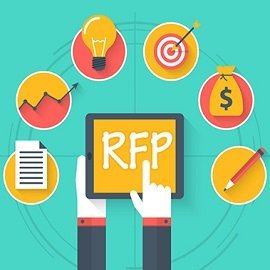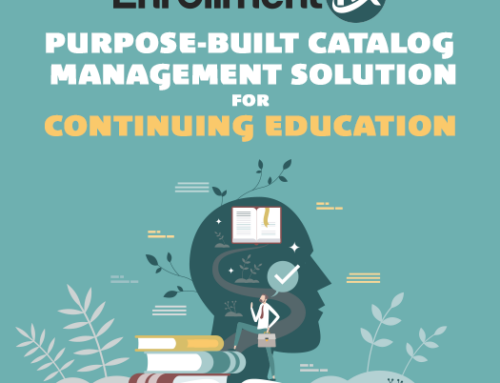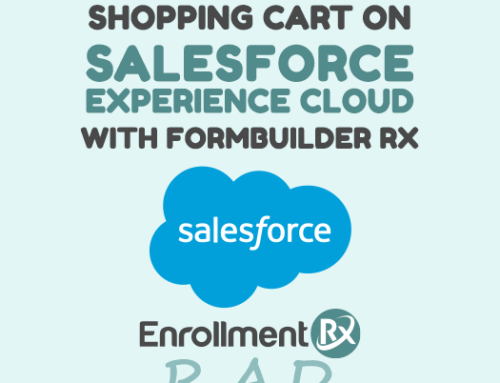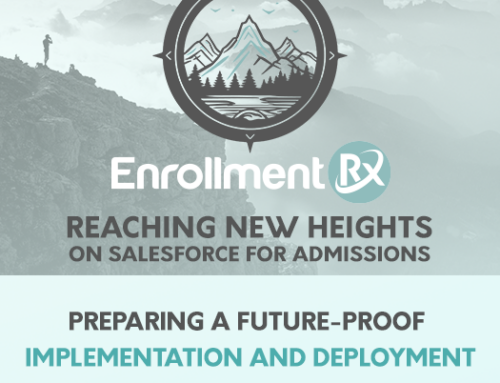When we started Enrollment Rx in 2008, CRM for higher ed was still in its infancy. Over the last few years, we’ve seen a huge uptick in colleges and universities understanding the value of CRM, and knowing that they need it.
For many schools, though, it can be a long and winding road between deciding they need a CRM to actually implementing the system. Admissions and student services departments have different goals. IT and admissions can’t always agree on system requirements. Legacy systems have created a slew of inefficient – and dare we say bad – habits that are hard to break. It’s a flurry of hurdles that, if not addressed, can snowball into delayed deployment or sub-par capabilities that threaten the system’s value.
I’m here to tell you it doesn’t have to be that hard. The key to a smooth CRM implementation starts at the very beginning — with an effective, strategic RFP process. For many, this may mean overhauling the traditional approach to RFPs, taking a fresh look at the all-too-often maligned business tool.
With this single, focused effort, you can make sure your CRM is creating efficiencies, not change management headaches. And by investing strategic thinking on the front end, RFPs can be a brilliant road map for a successful CRM implementation and user onboarding.
#1 Get Business and IT Involved
Navigating the cross-departmental collaboration during the RFP process is the first step to a successful CRM implementation that offers value across every department, and during every phase of the student lifecycle. An RFP isn’t simply an intake form. It should be the result of true collaboration.
To write a good RFP, you need to understand and identify your business requirements. This means getting business and IT stakeholders to sit down at the same table. Meet as a group to understand what you’re looking for. A 90-minute conversation with all decision makers – e.g. admissions, enrollment, IT, student services, etc. – and agreement to work together will produce a better high-level RFP.
In the most successful examples we’ve seen, the Director of Admissions and the CIO work hand in hand to write the RFP, view demos and jointly make the selection. This replaces the laundry list of overlapping questions from siloed departments with an RFP that is truly useful.
This was the case in one of the most organized and detail-oriented RFP processes we’ve experienced. The F.W. Olin Graduate School of Business at Babson College completed their cloud-based CRM implementation with Enrollment Rx in 2012. At the onset of their RFP process, they made sure they had executive sponsorship and a defined team of owners that spanned the business side and IT. As a result, they were able to successfully evaluate requirements for each department, while establishing clear goals and realistic expectations.
#2 Bring a Project Manager on Board Early
Writing and issuing an RFP is the critical first step of your CRM journey and equally important to all the other steps of the project that follow. For that reason, choose and assign a Project Manager (PM) before you write the RFP, not after you select finalists.
Too often, procurement drives the RFP process without any real familiarity with the business needs of CRM. Don’t rely on procurement. Instead, identify a clear sponsor of the project – someone who will be engaged throughout the life of the project, who can support the objective evaluation of business requirements, who will be invested in the outcome. The PM should be responsible for understanding and prioritizing requirements across different departments and then translating that to the right RFP questions that will appropriately narrow down the best solution for your needs.
As Petia Whitmore, dean of Graduate Admissions at Babson College, has shared in the past, technology is only as powerful as the business processes it supports and the people who use it.
#3 Develop a Project Charter
A stellar way to support your PM and justify the need for a CRM deployment is to develop a project charter. An effective project charter should include the following:
- current state of the business
- areas for opportunity
- reasons for the CRM implementation
- groups involved in the CRM implementation
- people / leadership involved in the implementation
- project goals
By creating a project charter before issuing an RFP, you’ll be able to better define project requirements early on, get buy-in from the right stakeholders, as well as benchmark quantitative and qualitative goals before, during and after implementation.
#4 Do Demos, and Ask for Proposals, Before Issuing RFPs
Most colleges and universities issue an RFP and then set up a demo with select vendors. I challenge you to think differently: do the demo first, then issue the RFP. Pick the best candidates for a demo right out of the gate. Then use insight from the demo to guide RFP writing.
By seeing a demo first, you’ll learn so much more about how each vendor positions themselves, where their strengths lie and how they may be a fit for your unique technical and business process requirements. In addition, this will give you a hands-on view of what’s available, what’s practical and what’s possible based on what actually exists.
In many cases, demos can also be a great way to break old habits that just aren’t serving the business any more. There are so many instances during the course of a demo or implementation that when we ask the client why they do something a certain way (e.g. review applications, track admission requirement checklist items, manage campus visits, etc.), the answer is: “because we’ve always done it that way.” This is a clue that a business process has morphed from a “system process” to a “people process,” which hinders the ability to scale and change quickly.
#5 Look to the Experts – Yourselves!
You are the experts.
Every single institution has its own unique requirements and you understand them better than anyone else. Tap into this expertise throughout the whole process: from writing the RFP to implementation to continuous innovation for how you’re automating processes.
But don’t go it alone. Make sure your technology vendor is also your partner in all things CRM. As we always tell clients, technology should support, not govern, business processes.
Select a vendor that will deliver both the technical solution you need as well as the guidance to support any process re-engineering that needs to occur as a result of the deployment. Remember: the objective of the CRM implementation is not simply to duplicate what you do today. Some vendors will “do” exactly what you want, while other vendors will approach the relationship as a collaborative process in order to align goals and maximize results. With the right vendor, this re-engineering will take full advantage of the capabilities of the CRM and incorporate your institution’s goals and objectives as outlined in the project charter. That way, you can make the CRM adoption as valuable as possible – not just from a financial standpoint, but also from the standpoint of time, resources and energy investment.
The time that you spend upfront, during the RFP process, will come back to you in spades. Advance work will save you change management headaches and lay the foundation for a faster, more mature implementation. With some upfront “soul searching,” collaboration and organization, you’ll be better prepared to take full advantage of whatever CRM system you put in place and allow for greater change that delivers more value.
Have a great RFP story to share? What are your tips for driving success in RFPs?




